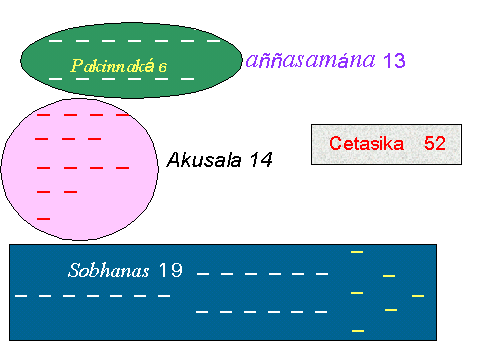Abhidhammattha-Sangaha
CHAPTER II - Mental States (cetasika)
Introduction(Definition) l
52 Kinds of Mental States l Different Combinations of Mental
States l Immoral Mental States
l Beautiful Mental States l Contents of Different
Types of Consciousness l Supra mundane Consciousness (Sublime Cons.)
Sense-Sphere Beautiful Consciousness l Immoral
Consciousness l Rootless Consciousness
Introduction
In the 89 types of consciousness, enumerated in the first
chapter,
52 mental states arise in varying degree.
|

|
There are 7
concomitants common to every consciousness.
There are 6
others that may or may
not arise in each and every consciousness. They are termed
Pakinnaká (Particulars).
All thes13 are
designated aññasamána
, a rather peculiar technical term. Añña
means 'other', samana means 'common'.
Sobhanas, (Good), when compared with
asobhanas (Evil,) are called añña - 'other', being of the
opposite category.
So are the asobhanas in contradistinction to Sobhanas.
|
These 13 become
moral or immoral
according to the type of consciousness in which
they occur.
14 concomitants are
variably found in every type of
immoral consciousness.
19 are common to
all types of moral consciousness.
6 other
moral concomitants occur as
occasion arises.
Thus these fifty-two (7 + 6 + 14 + 19 + 6 = 52) are found
in the respective types of consciousness in
different proportions.
In this chapter all the 52 mental states are
enumerated and classified.
Every type of consciousness is
microscopically analyzed, and the accompanying mental states are
given in detail. The type of consciousness in which
each mental state occurs, is also described.
To an impatient lay reader this
chapter will appear rather dry and
uninteresting.
To a critical and intelligent reader
it will, on the contrary, serve as an
intellectual treat.

At the outset, for instance, a
student of chemistry may find the numerous chemical
formulas somewhat perplexing. But he finds the subject
interesting and edifying, when he seriously
attempts to analyze and examine the various substances
with different tests.
In like manner a student of Abhidhamma who reads this chapter
should first try to
analyze and examine
care fully every type of consciousness and see for
himself the mental states thereof according to
his own reasoning.
Later, he should
compare his results with
the original text. He will then find this
chapter most illuminating, and instead of
wasting time in memorizing numbers, he will
intelligently grasp the meaning of the text.
|
 |
For example, let us analyze the first immoral type of
consciousness, rooted in attachment.
Somanassa-sahagata - Accompanied by pleasure,
Ditthigata-sampayutta - Connected with misbelief,
Asankhαrika - Unprompted.
This consciousness, when analyzed, will show that the
vedanα or feeling is pleasure'.
The 7 Universals and all the Particulars are found in it.
The 4 Immoral mental states common to all immorals such as
moha (delusion), ahirika (shamelessness), anottappa,
(fearlessness), and uddhacca (restlessness) must arise in it.
What about the remaining ten?
- Lobha - attachment must arise.
- Ditthi - misbelief must arise.
- Mαna - conceit cannot arise.
Conceit does not arise in lobha consciousness,
together with misbelief. Ditthi is connected with wrong view, while
mαna is concerned with egoism. Both of them, say the commentators, are
like two lions that cannot live together in one cave.
Dosa (hatred), issα (envy), macchariya
(avarice), and kukkucca (brooding) cannot arise, because these four are
akin to aversion. They are found only in hateful consciousness.
Thνna and middha - (sloth and torpor) do not
arise because this is an unprompted consciousness.
No sobhanas - (beautiful) occur in an immoral
consciousness.
Total - 7 + 6 + 4 + 2 = 19.
Thus, on analysis, we see that the first immoral
consciousness consists of 19 mental states.
The other types of consciousness should be similarly
analyzed.
(Definition)
§ 1. Ekuppαda-nirodhα ca - ekαlambanavatthukα
Cetoyuttα dvipaρραsa - dhammα cetasikα matα.
§ 1. The fifty-two states that are associated with
consciousness, that arise and perish together with consciousness, that have
the same object and basis as consciousness, are known as cetasikas
(mental states).
Notes:-
1. Cetasika = Ceta + s + ika
That which is associated with mind or consciousness is
cetasika. (Sanskrit - caitasika or caitti).
Definition-
Cetasika is
(i) that which arises together with consciousness,
(ii) that which perishes together with it,
(iii) that which has an identical object with it,
(iv) that which has a common basis with it.
Readers will note that the author has not given here a
logical definition according to genus and species. Instead he speaks of four
characteristic properties of a cetasika. The Commentator cites reasons
for attributing these four properties.
No consciousness exists apart from its concomitants. Both
consciousness and its respective co-adjuncts arise and perish simultaneously.
But there are some material qualities such as viρρatti rϊpa* (Modes of
Intimation) - that arise and perish simultaneously with the consciousness. To
exclude them the third property of having a common object has been attributed.
That which possesses these three characteristics must necessarily be endowed
with the fourth - a common basis.
*[ Kαyaviρρatti (mode of action) and
Vaci Viρρatti (mode of speech)]
According to Abhidhamma, mind or consciousness is
accompanied by fifty-two mental states (cetasikas).
One of them is vedanα (feeling); another is saρρα
(perception). The remaining fifty are collectively called sankhαrα.
Cetanα (volition) is the most important of them.
The whole group of feelings is called vedanα-kkhandha.
So are saρρα-kkhandha and sankhαra-kkhandha.
Dvipaρραsa Cetasika
(Sabbacittasαdhαranα-7)
Katham?
§ 2. (i) 1. Phasso, 2. Vedanα, 3. Saρρα, 4. Cetanα,
5. Ekaggatα, 6. Jνvitindriyam, 7. Manasikαro c'αti satt'ime Cetasika
Sabbacittasαdhαranα nαma.
(Pakinnakα - 6)
§ 3. (ii) 1. Vitakko, 2. Vicαro, 3. Adhimokkho, 4.
Viriyam, 5. Pνti, 6. Chando c'αti cha ime Cetasikα pakinnakα nαma.
Eva'mete Cetasikα Aρρasamαnα'ti veditabbα. (13)
(Akusala - 14)
§ 4. (iii) 1. Moho, 2. Ahirikam, 3. Anottappam 4.
Uddhaccam, 5. Lobho, 6. Ditthi, 7. Mαno, 8. Doso, 9. Issα, 10.
Macchariyam, 11. Kukkuccam, 12. Thνnam, 13. Middham, 14. Vicikicchα
c'αti cuddas'ime Cetasikα Akusalα nαma.
§ 5. (iv) 1. Saddhα, 2. Sati, 3. Hiri, 4. Ottapam,
5. Alobho, 6. Adoso, 7. Tatramajjhattatα, 8. Kαya-passaddhi, 9.
Citta-passaddhi, 10. Kαya-lahutα, 11. Citta-lahutα, 12. Kαya-mudutα, 13.
Citta-mudutα, 14. Kαya-kammaρρatα, 15. Citta-kammaρρatα, 16.
Kαya-pαguρρatα, 17. Citta-pαguρρatα, 18. Kαyujjukatα, 19. Cittujjukatα,
c'ati ek' unavνsat'ime Cetasikα Sobhanasαdhαranα nαma.
(Viratiyo-3)
§ 6. (v) 1. Sammα-vαcα, 2. Sammα-kammanto, 3.
Sammα-αjνvo c'αti tisso Viratiyo nαma.
(Appamaρρα-2)
§ 7. (vi) 1. Karunα, 2. Muditα pana Appamaρραyo nαmα'ti
sabbathα'pi-
(Paρρindriya-1)
§ 8. (vii) Paρρindriyena saddhim paρcavνsat'ime
Cetasikα Sobhanα'ti veditabbα.
§ 9. Ettαvatα ca -
Teras' aρρasamαnα ca - cuddasαkusalα tathα
Sobhanα paρcavνsα'ti - dvipaρραsa pavuccare.
top next

